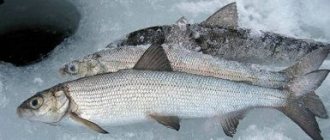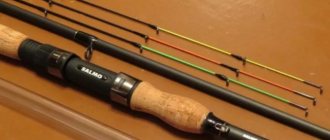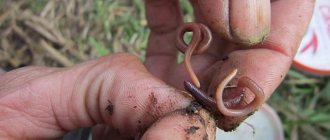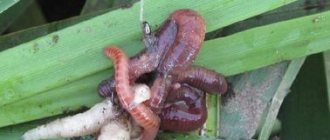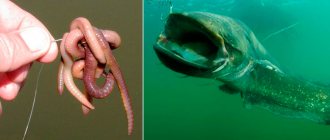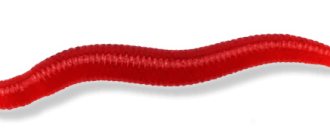Collecting worms
Crawlers are among the largest worms. After all, their length sometimes reaches almost 30 cm, and their thickness is 9 mm. The head of such a worm is thicker and darker than its entire body. And the tail part is somewhat flattened. Light-colored crawlers are best suited for fishing. They are more tenacious and durable than dark worms.
If you live in your own home or have a summer cottage, then there is an exceptional option for collecting crawlers and other types of worms. So, in some darkened area, choose a flat place with rich soil.
It is recommended to lay old rags, all saturated with moisture, straw, rotted hay on it, and last of all, old boards should be laid. Just a little time will pass, and it is to this place that the worms themselves will begin to crawl. These will include crawling worms, earthworms, and dung worms.
You don't even have to dig for bait. Just pick out the crawlers from the straw - that’s all. Although such a “breeding ground” for worms requires care. This means that in hot and dry weather, it is recommended to moisturize this place. Just water with cold water. Now you will have a ton of worms. And this source will not dry up. After all, the crawlies will multiply in a favorable place, constantly replenishing your supplies of bait for fishing.
Where to find?
You don’t need any special skills to find crawlies. It is recommended to just take a leisurely stroll along the garden and park paths, carefully looking at everything around you. In those places where there are small piles of earth, they crawl out and live. If you move this pile a little, you will see a small hole. Most often it is covered with an ordinary leaf.
When to look?
It is best to look for worms in the dark.
It is recommended that in the evening you come to the place where you previously saw heaps of earth, and point a flashlight there, you will definitely see a crawl.
He loves to lie next to his mink. Moreover, the tail part of the earthworm’s body may be lowered in the hole at this time.
That is why it is recommended to pull out the crawl with the greatest care, so as not to tear its body in half.
This is best done with three fingers, slowly and gently.
Worms do not like bright light, so you should not shine a flashlight directly on them. After all, the crawler will quickly hide in its hole. And you definitely won’t have time to catch him. There is no point in excavating the habitats of these worms. This will not be successful because the worm holes run insanely deep.
Basic methods for successfully hunting crawlers:
- crawlers leave their habitat preferably after rain in the dark. You better give the worms time to adapt. And after several hours after dark, you can go hunting. This is the optimal period for catching crawlers;
- Even before dark, during the daytime, you need to select several places that are most suitable for crawling to live. Moreover, the vegetation here should not be high. After all, you will have virtually no chance of finding a worm in the dark. Lawns deserve special attention, including open areas between bushes and trees;
- It is important that the flashlight is not very bright. Because crawlers never completely leave their habitat - earthen burrows. Their tail remains inside the shelter. And when even the slightest danger arises, they immediately hide. It will be impossible to get them;
- It is recommended to catch the crawler as close to the tail as possible. And hold it carefully until it weakens. Under no circumstances should you pull the worm - you will rather tear it into pieces than pull it out of the hole. Starve it out. This option is more effective;
- in the case when the weather is not encouraging with rain, and you need to get crawlers for fishing, there is a little trick. So, in the late afternoon, you should water the area of land where the worms are expected to live, and wait. After some time, with the onset of darkness, they will definitely appear.
How to catch crawlies
Hunting for crawlies is no less exciting than fishing itself. This activity requires even more dexterity, dexterity, caution and patience than fishing. Quite often it lasts almost until the morning, especially during the summer heat. On hot days, crawlers go deep into the ground and may not appear on the surface at all, even at night. Rainy weather is a completely different matter. If it rained well during the day, these worms will definitely show themselves when darkness falls. You can also try to lure them out. For example, pour several large buckets of water over loose soil somewhere in the garden. The crawlers will sense the moisture and immediately be drawn to it. It is important that there is no vegetation in the artificially moistened area, as it will greatly interfere. It is much more difficult to catch a worm in the grass.
Another difficulty lies in the fact that the crawlers almost never crawl out completely. They leave a tail in the hole and, at the slightest danger, “dive” into the ground at the speed of a bullet. This means that you need to behave with extreme caution. When the flashlight beam snatches the thin body of the worm from the crown of the head, the light must be dimmed immediately - taken a little to the side. Next, you need to try to approach silently (the crawlers feel the vibration of the soil), bend down quietly and press the worm to the ground with the fingers of your free hand. At this crucial moment, you should use all your restraint and not give in to the temptation to pull it out right away. Many are in a hurry and begin to pull, which is why the crawl simply breaks and one half of it remains in the hole. This cannot be allowed. Let it resist, strain and lose strength, and when it weakens (after about 30 seconds), then you can begin to slowly remove it from the ground. This is the only way the worm will remain safe and sound, that is, alive and suitable for fishing. To be sure to catch crawlers, you need to use a light source that is not too bright and wear soft shoes that do not create noise when walking. By the way, many modern flashlights have a diffused light mode. Everything else is a matter of technique. After a couple of torn worms, you will understand how to get them out correctly.
Storage
The storage of crawls must be taken with special responsibility. Because worms are very capricious and spoil very quickly. Experts recommend using a wooden or plywood box to preserve the crawlies. For example, a parcel box is perfect.
If possible, it is best to put a little moss on the surface of the bottom of such a case.
But in principle you can do without it. Experienced fishermen recommend replacing moss with knotweed.
So, you need to put at least half of the grass in the box, or even two-thirds of it.
It is in this slightly moistened vegetation that the crawls are stored in the cellar, basement or other cool place.
If you need to store the worms for a couple of days, then they won’t die just in the shade either. But not for very long. The main thing is to avoid direct sunlight.
Do not store crawlies in concert jars or plastic bags. It is not right. It is best to choose a box, as mentioned earlier, with moss. Although the land in which they were looking for crawlies would also be a good option.
Collecting bait
Collect crawlers in the dark using a powerful flashlight, inspecting the ground in the space between the grass. The crawler does not like grass that is too tall and dense; it is usually found in the short grasses of floodplain meadows, pastures, and abandoned vegetable gardens. The places where crawlers emerge to the surface will show holes in the soil ranging in size from 2 to 5 mm. It is worth noting that the worm is not very afraid of light, but is sensitive to sound. When collecting crawlings, try to walk on the ground quietly and not make noise.
It is even easier to collect crawlers in the city - this is usually done at night on the lawns of city parks and alleys. During heavy rains, suffocating in their burrows, the crawlers crawl out en masse to the surface of the earth, onto the asphalt and park paths. When collecting them at this time, you must definitely dry the worms (you can use paper napkins) and place them in the soil, preferably from the places where you collected them.
Storage
You can store crawlies in the lower fruit and vegetable section of the refrigerator in wooden boxes, in foam boxes, or in enamel dishes. The container should be filled with a sufficient amount of moderately moist, but not wet soil, into which you can add a little rotted foliage. Air access, of course, is required.
Once every few days it makes sense to feed the worms with a small amount of broth, a couple of pinches of cottage cheese, and add a little bran. If all conditions are met, the crawlies can live in your refrigerator for several weeks. When going fishing, the required number of worms are taken into a spacious container with soil.
What to feed crawling worms?
This may surprise you, but crawlers eat almost everything. These can be bread crumbs, cottage cheese, leftover cereals, kefir and much more. The only important thing is that this food is not salty. If you want to prepare something special for the crawls, then rolled oats would be an ideal option.
Moreover, it doesn’t have to be cooked. They also eat dry food. It’s just worth considering the fact that dry rolled oats will absorb moisture, taking it away from the soil. Therefore, you should thoroughly water the ground, add porridge there, and mix everything thoroughly.
Bran is also suitable as food for crawling animals. They are easy to get, and they cost much less than rolled oats.
Under no circumstances should you add leaves to the soil. Since they are in the process of decay, they absorb a lot of oxygen. This will negatively affect the well-being of the worms.
Crawling fishing
Crawling fishing is simply ideal for a large trophy. Because a small fish is unlikely to be able to eat such bait. Most often she cannot do this.
You can place the crawlers on the hook either in parts or as a whole. It all depends on what kind of fish will be hunted and what gear is used. Barbel, ide, bream, carp, carp, large perch and even pike or catfish bite well on a large worm, and gudgeon, ruffe, silver bream and roach bite on a small worm.
For example, you decide to hunt catfish. To do this, it is advised to put a whole bunch of crawlers on the hook and choose the right fishing gear for this. The fish will not be able to refuse such a delicacy. Therefore, he will definitely go on the attack.
Good luck with your bite and big catch! When crawling out, you are sure to catch a trophy-sized fish!
What is the difference between a crawler and an earthworm?
- Color . Earthworms are usually red-brownish in color. It is typical for the average worm. There are earthworms in various pink shades. There are worms of off-white or off-yellow color. The crawl has a bright dark brown hue.
- Dimensions . Earthworms are significantly smaller and thinner than crawlies. The length of crawlers can reach up to 30 cm, while the length of earthworms varies within 10 cm (sometimes more, sometimes less). The thickness of the crawlers reaches up to a centimeter, while the thickness of an ordinary earthworm is approximately half a centimeter.
- External form . The head of earthworms basically merges with the body. The body itself tapers towards the tail. The head of the crawler will stand out against the background of the body. And the tail part of the crawl looks flattened.
- Habitat . Earthworms begin to reproduce in any soil immediately after rains. Crawlers live exclusively in the noble soils of vegetable gardens and flower beds.
- Behavior . The crawlers are very shy and at the slightest noise they immediately retreat into their holes. And earthworms, in general, for some unknown reason, do not experience any fear.
Purpose for fishing. The largest fish are caught on crawling fish. For example, catfish, pike. And earthworms are already used where the fish are smaller.
That, perhaps, is all the difference between worms and crawlies. So, when getting ready for fishing, do not forget to get those worms that suit you best!
